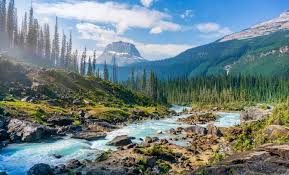1.National Parks in Uttarakhand – Introduction
National Parks in Uttarakhand play a vital role in preserving the high biodiversity of the state. Surrounded by the majestic Himalayas and verdant valley landscapes, Uttarakhand has some of India’s most diverse fauna and flora. These national parks serve as safe spaces for vulnerable species and receive nature lovers, trekkers, photo-graphers, and wildlife photographers from across the globe. Besides their ecological significance, these national parks contribute substantially to eco-tourism and local economies.
2. List of Major National Parks in Uttarakhand
a. Jim Corbett National Park
Jim Corbett National Park is the oldest and amongst the most renowned national parks in India and Uttarakhand. It was formed in 1936 and is famous for the presence of Bengal tigers and diverse wildlife.
Safari Options: Jeep safari and canter safari are the options to visit the dense forests and see animals.
Wildlife: Habitat to tigers, leopards, elephants, deer, crocodiles, and more than 600 bird species.
Accommodation: Provides forest lodges, luxury resorts, and budget hotels within and around the park.
b. Rajaji National Park
Near Haridwar, Rishikesh, and Dehradun, Rajaji National Park is another national park in Uttarakhand that is famous for its scenic beauty and rich wildlife diversity.
Best Time to Visit: November to June
Wildlife: Elephants, leopards, goral, and over 300 species of birds
Eco-Tourism: Provides jungle safaris, bird-watching excursions, and camping options
c. Nanda Devi National Park (UNESCO World Heritage Site)
A component of the Nanda Devi Biosphere Reserve, this high-altitude national park in Uttarakhand is a World Heritage Site of UNESCO. It consists of dramatic mountain scenery, glaciers, and alpine meadows.
Trekking: The park can be accessed through treks and is popular with adventure lovers.
Flora & Fauna: Features such endangered species as Himalayan musk deer, blue sheep, and snow leopard, along with varied Himalayan flora.
d. Valley of Flowers National Park
But another UNESCO World Heritage place, the Valley of Flowers National Park is famous for its beautiful meadows of alpine flowers and medicinal herbs.
Flowering Period: July to September would be the best time to view the valley in flower.
Trekking Tips: A medium-length trek via Govindghat along Ghangaria leads to the valley. No motor traffic is allowed within.
Photography: A paradise for nature photographers and botanists too, especially during monsoon bloom.
e. Gangotri National Park
Stretching over the upper catchment of Bhagirathi River, Gangotri National Park is among the most picturesque national parks of Uttarakhand.
Landscape & Species: Involves glaciers, rough landscapes, and threatened species such as snow leopards, brown bears, and Himalayan monal.
Spiritual Importance: Situated close to the Gangotri Dham, it appeals to both nature enthusiasts and pilgrims.
Eco-Trekking: Perfect for high-altitude trekking and watching pristine Himalayan wilderness.
3.Wildlife Species Found in These Parks
Uttarakhand National Parks are a paradise for wildlife lovers, providing an opportunity to observe some of the world’s most iconic and endangered species in their natural habitats.
Bengal Tiger: The pride of Jim Corbett National Park, famous for its power and regal demeanor.
Asiatic Elephant: Frequent inhabitants of Rajaji National Park, these gentle animals are free to roam in herds.
Musk Deer: A rare animal occurring in high-altitude sanctuaries such as Nanda Devi, it is revered for its precious musk gland.
Snow Leopard: A rare predator seen in Nanda Devi and Gangotri National Parks, particularly during winter.
Bird Watching Highlights: With a range of over 600 bird species, such as the Himalayan monal, great hornbill, as well as other migratory birds, Uttarakhand’s parks are heaven for bird watchers.
4.Best Time to Visit National Parks in Uttarakhand
The best time to visit national parks in Uttarakhand varies with season and location of the park.
Summer (March to June): Optimum for wildlife safaris, trekking, and birding because of clear weather.
Monsoon (July to September): Ideal for Valley of Flowers, but a few parks are closed because of heavy rains.
Winter (October to February): Ideal for snowscapes and viewing high-altitude wildlife in a few parks.
Safari Timings: Most canter and jeep safaris run early morning and late afternoon for optimal viewing. Online advance booking is advised, particularly in Jim Corbett and Rajaji.
5.How to Reach the National Parks
The national parks in Uttarakhand are easily accessible with various transport facilities:
By Air: Jolly Grant Airport (Dehradun) is the nearest for Rajaji, Valley of Flowers, and Gangotri. Jim Corbett is served by Pantnagar Airport.
By Rail: Ramnagar Railway Station for Jim Corbett, Haridwar/Dehradun for Rajaji, Rishikesh for trekking trails, and Kathgodam for the parks of the north.
By Road: There are well-connected roads in Uttarakhand. State buses, private taxis, and self-drive vehicles are common means of reaching park entry points
6.Travel Tips for Visitors
Traveling to National Parks of Uttarakhand can be a memory that will last a lifetime if planned properly.
Permits: All parks have entry permits, which are available online or on the entrance gate. Jim Corbett and Nanda Devi need pre-bookings.
Guides: Employing trained local guides ensures safety, enhanced wildlife sighting, and a greater understanding of the area’s biodiversity.
Do’s and Don’ts: Remain silent on safaris, don’t litter, don’t feed wildlife, and use defined trails.
7.Conservation Efforts in Uttarakhand
The local communities and the state government are in active efforts to safeguard National Parks in Uttarakhand.
Government Efforts: Anti-poaching patrols, restoration of habitats, and more stringent control over tourism activities.
Community Involvement: Local villagers are engaged in eco-tourism activities, handicraft marketing, and guided treks, generating sustainable livelihood.
Eco-Tourism & Sustainable Practices: An energy promotion of renewable sources in park lodges, safari routes regulated, and sensitization programs for tourists to reduce ecological footprint.
8.Conclusion
With its unspoiled beauty, native wildlife, and heritage wealth, National Parks in Uttarakhand are a wildlife enthusiast and nature lover’s haven. From the excitement of spotting a Bengal tiger at Jim Corbett to witnessing the flower paradise in the Valley of Flowers, there is something unique to explore in each park. Exploring these parks not only amazes tourists but also funds protection schemes, which preserve Uttarakhand’s natural wealth for generations to come.



